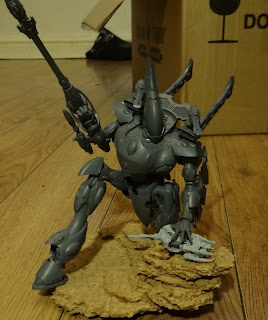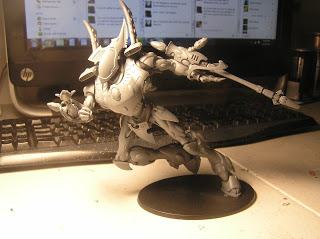 Hey Folk, And welcome to another Inside Look. It's a little behind, But having had a chance to put one of these together, I've had a good look at the model, and how it comes to you in the box.
Hey Folk, And welcome to another Inside Look. It's a little behind, But having had a chance to put one of these together, I've had a good look at the model, and how it comes to you in the box. Right away when you purchase the model, you'll notice something quite different. The model isn't shrink wrapped. This is very unusual as it is the first time a model that isn't a blister pack has been shipped without it's protective plastic wrapping. The box itself is a much thicker material than the usual boxes we're used to. It's kept shut by a cardboard lip which makes for getting the sprues out a little more of a hassle than usual, but nothing a semi-compitent human being can't handle.
One of the nice things about this kit is that the instructions mention the parts by number, and all of these numbers can be easily read from the sprues themselves. It is also worth noting that the instructions I handled were 100% correct and had no oddities. The numbers were always correct and the pieces depicted in the instructions were always the correct piece. As this was one of the first run boxes, it was nice to see GW took the time to get this right.
Now we are talking about an Eldar construct here, so almost every piece of this model is curved, rounded, or sloping in some way. Because of this, there are very few places you can connect the model parts to the sprue itself without dinging up the parts, and so you'll run into rough patches on exposed areas where the knife digs into the detail a bit. This is thankfully kept to a minimum with the design of the connection points. Yet another thing done well within the confines of the box. But as I said, there are still some rough areas on my model where I just couldn't make it work perfectly.
Now, here is where things started to get a little frustrating for me as a builder. Recently, I also had a chance to experience some of the other kits of this size. Most notably I built a Riptide for a fellow gamer, and it was then I had noticed something the Riptide had that was very clearly not found in the Wraithknight box.
The Riptide is a work of art, and it meant to be shaped and posed in many different ways. Because of this, the model is build by pinning the extremities into the torso. These pins are plastic and are a part of the kit itself as a design element. It's actually pretty innovative in terms of GW's models. Before models were rather simplistic, or at the very least would come with several version of the same limb which gave options for looks. This new system allows for almost every model to be pretty dynamic and unique in their look.
Now... The Wraithknight offers somewhat less in this regard. It has 2 sets of arms. One extended, and one at a 90 degree angle for both the left and right arms... as well as an open and closed fist for each hand (as well as an addition right hand which carries the sword). The legs are basically a single pose with opposable knee joints. This is really a let down given this model came out after the Riptide. That said, it isn't impossible to make this model dynamic. In fact there are several different looks you can give this model out of the box, with no or very little conversion. I didn't find as many options as that of the Riptide, but there is still enough here to make the model varied enough for a single player's army.
The other limiting factor here is that without some fairly extensive cutting and green-stuffing, the legs only connect to the pelvic section in a single way. This is severely limiting to the look and feel of the model out of the box. Combining this with the a fore mentioned curves and slopes of Eldar constructs and you have a very difficult model to make look unique.
Now... to be fair, Eldar Wraith constructs are fairly slow and move much like the Ents in Lord of the Rings, very slowly, and very deliberately. As such, the need for dynamic posing is less "required" by that virtue. Whatever the case, there is much less inherent possibility with the model right out of the box than it's Tau cousin.
Now, I said before there is a reason I chose this model, especially given what I have said about the Riptide. The Riptide was free (mostly) from the bounds of aesthetic design. While it's roughly based on the idea of the Tau Crisis suits, it's really it's own unique model. Wraithknights are wraith constructs. These constructs are almost all the same in look, from Wraithguard to the Phantom Titan. The design of this model really nails the looks of the wraithbone construct, while providing some bridges which were previously missing. If you think of the gap before this model hit the shelves, there was nothing between a Wraithlord and a Revenant Titan. If you notice, the heads and backs of these two models are quite different. The Wraithknight basically fills that gap by have elements of both, and as such it feels like the "missing link" between Eldar tech.
Another reason this model was chosen was for its user friendliness. A lot of players in the 40k crowd are not extensive hobbyists. Because of that, high count parts lists for models can tend to scare some players away. This model is the largest non-apoc unit out to date, and it does so with relatively few parts. The whole of the kit has 114 parts, of which many will not be used in a single build. I built mine with a Sun Cannon, scatter laser, and Shield, and looking in the kit I still have 19 parts left. The riptide only has 108 parts, but I was left with only 5 extra parts. Each of those were swap parts and as such were magnified. this means every part was used. While yes I could have magnetized the Wraithknight... it felt much less necessary for the build. The smaller part count should be factored in as a reason for it's lack of posing options. So good with bad here.
Overall the kit is a very solid buy. It offers highly detailed sections (around the head, back, and upper torso) juxtaposed to smooth, elegant limbs quintessential to the Eldar look. Because of this, i feel the model offers a great look and feel for and Eldar army when competed. Additionally, given it's possible use as a Warlord for the Iyanden army, the unit has a good model to back up such a significant position by sheer presence the model has aesthetically on the table. In my opinion it requires an artist's touch to make it truly unique, but it will be the centerpiece of any army easily if done well. If you're willing to put in the work, it's definitely worth the endeavor. Just be sure you know what you're getting yourself into if you wanna make it unique.
Cheers!







I do personally love the aesthetics of the model and it really does make for a huge presence on the battlefield. I know there are a lot of people who aren't fans of the "Centerpiece models" But i personally like to see them on the table. Especially when they are going up against each other.
ReplyDeleteOn an editors note: I think magnetized is the word you were looking for.